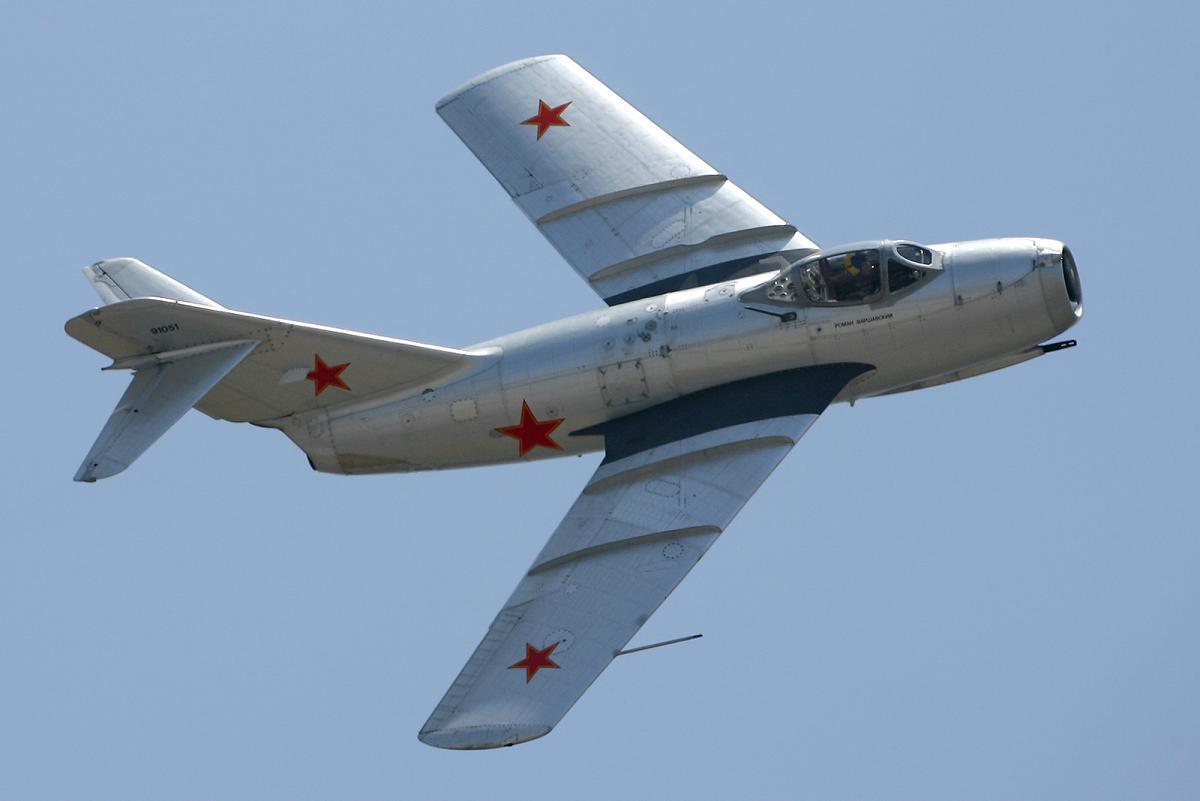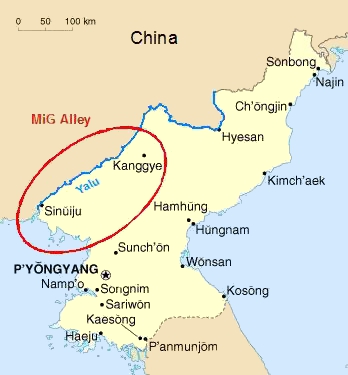The MiG-15 was the great soviet interceptor, for the days. It still is one of the best ever jets made by Mikoyan-Gurevich, as proved by various pilots from around the globe. And not only does the North Korean Air Force still operate MiG-15s, but there is also some in proivate hands mainly for air shows. And MiGFlug offered already flights in Poland in cooperation with Polskie Orly – and is now offering MiG-15 flights in Czech Republic.
But back to history: The first upgrade to the aircraft came in 1951, with the arrival of the MiG-15bis. While the aircraft contained numerous minor improvements, it also possessed the brand new Klimov VK-1 engine and external hard points for rockets and bombs. Widely exported, the Soviet Union provided the aircraft to the People’s Republic of China. First seeing combat at the last fights of the Chinese Civil War, the MiG-15 was flown by Soviet pilots from the 50th IAD. The aircraft scored its first kill on April 28, 1950, when one pilot managed to successfully down a Nationalist Chinese P-38 Lightning.
With the outbreak of the Korean War in June 1950, the North Koreans began operations flying a variety of piston-engine fighters. These were soon swept from the sky by American jets and B-29 formations began a systematic aerial campaign against the North Koreans. With the Chinese entry into the conflict, the MiG-15 began to appear in the skies over Korea. Quickly proving superior to straight-wing American jets such as the F-80 and F-84 Thunderjet, the MiG-15 temporarily gave the Chinese the advantage in the air and ultimately forced United Nations forces to stop daylight bombing. Fought from June 1950 to July 1953, the Korean War saw Communist North Korea attack its southern, democratic neighbour. Backed by the United Nations, with many of the troops furnished by the United States, South Korea resisted and fighting began and flowed up and down the peninsula until the front stabilised just north of the 38th Parallel. A bitterly contested conflict, the Korean War saw the United States follow its policy of containment as it worked to block aggression and halt the spread of Communism. As such, the Korean War may be seen as one of the many proxy wars fought during the Cold War.
When the chaotic Korean War escalated with the North Korean offensive of 25 June 1950, the North Korean Air Force was equipped with World War II-vintage Soviet prop-driven fighters, including 93 Il-10s and 79 Yak-9Ps. The Fagot’s performance left its western enemies amazed. The British Chief of the Air Staff said “Not only is it faster than anything we are building nowadays, but it is already being produced in highly large numbers . . . The Russians, therefore, have achieved a four year lead over British development in respect of the vitally important interceptor fighter”. The MiG-15 proved very effective in its designed role against formations of B-52 heavy bombers, shooting down successfully, numerous bombers. In a match-up with the F-86, the results were not as clear-cut and crisp though Americans claimed that the F-86 had the advantage in combat kills. (But the F-86 is American!) The Communists chose to challenge American air power principally in “MiG Alley,” MiGs could launch from the Antung complex of airfields in Chinese Manchuria and be ready to fight within a few minutes, whereas Sabre pilots needed to fly a considerable distance just to make it to MiG Alley, let alone fight there. Basically, MiG Alley was at the edge of the F-86’s endurance. Sabre pilots often had less than 20 minutes’ on-station time before they had to return to base.
MiG Alley
The MiG Alley is the northwestern quarter of North Korea bounded on the west by the Korea Bay and on the east by a line running roughly between the Sui-ho Reservoir and the town of Huichon. The Soviets held the presence of their aircrews in the Korean War secret for many years, though it was widely suspected by UN forces. For radio communication, they were given cards with common Korean words for various flying terms spelled out phonetically in Cyrillic characters. Soviet aircraft were adorned with North Korean or Chinese markings and pilots wore either North Korean uniforms or civilian clothes, to disguise their origins.
The US flew the MiG-15 in 1953
A MiG-15 that was stolen by North Korean defector No Kum-sok, the youngest pilot in the North Korean Air Force. No Kum-sok flew his Mikoyan-Gurevich MiG-15 from Sunan near Pyongyang to Kimpo Air Base in South Korea on the morning of September 21, 1953. Total flight time from North Korea to landing in Kimbo Air Base in the South was 17 minutes, with the MiG-15 reaching a top speed of 620 MPH (998km/h). Seems No was quite in a hurry! He was not intercepted by North Korean or American forces on his way. The radar around Kimbo was shut down for maintenance that very morning. Also, No finally landed from the wrong direction on the runway, and by doing so almost hit an American F-86 Sabre jet landing at the same time from the opposite direction.
According to Blaine Harden, the American Sabre pilot (Captain Dave William) dodged on the and radioed “It’s goddamn MiG!”. Captain Jim Sutton, a second American pilot who was circling the airport at the same time, said if No landed in the right direction he would have been shot down. After landing, No taxied his MiG-15 into a free spot between two Sabre jets, got out of the jet and began tearing up a picture of the North Korean leader Kim Il-sung. No was awarded with USD 100,000 (Almost a million in today’s USD).
See the story of the US testing the MiG-15 in the video below.
https://youtu.be/NPOWfXhCWkI
Additional Readings –
- MiG 15 Fagot – The 65 year old jet still going strong!
- Did you know that fighter planes sizes vary heavily?
- Do you know them? The fastest planes in the world
- The legendary SR-71 Blackbird
- The US Mach 3 Bomber
Author – Jake Meilak, Philipp Schaer



Neueste Kommentare